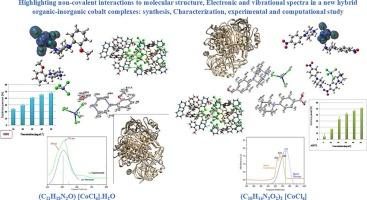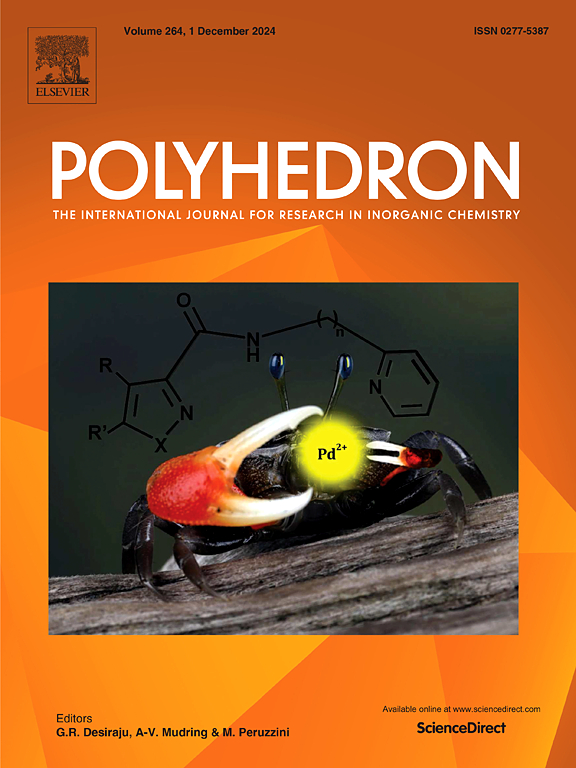新型有机-无机杂化钴配合物的分子结构、电子和振动光谱中的非共价相互作用:合成、表征、实验和计算研究
IF 2.4
3区 化学
Q2 CHEMISTRY, INORGANIC & NUCLEAR
引用次数: 0
摘要
钴(II)配合物是由阳离子实体(1-(2-甲氧基苯基)哌嗪和 1-(4-硝基苯基)哌嗪)与金属盐 CoCl2-6H2O 反应,然后在室温下用蒸发晶体生长法合成的。合成的配合物通过单晶 X 射线衍射、Hirshfeld 表面分析、紫外可见光谱、傅立叶变换红外光谱、光致发光和 TGA/TDA 分析进行了全面表征,并进行了理论研究,此外还进行了抗氧化 DPPH+自由基和 ABTS+自由基阳离子检测。晶体结构分析表明,这两种复合物均为正方晶系结晶。红外光谱鉴定了振动吸收带。在室温下获得了标题化合物的固态紫外-可见吸收光谱,以观察其光学性质。在 [300-700 K] 范围内,对热行为进行了研究,结果表明这两种络合物与金属络合物残留物发生了分解。Hirshfeld 表面分析和二维指纹图显示了固态相中主要的分子间相互作用及其贡献。从晶体结构中获得的两种复合物的分子几何结构被用于量子化学计算。利用 DPPH+自由基和 ABTS+自由基阳离子检测法突出了这两种复合物的抗氧化活性,其中化合物(1)的 IC50 大于 45 毫克.毫升-1,化合物(2)的 IC50 大于 49 毫克.毫升-1。还通过分子对接对所研究复合物的抗癌活性进行了硅学研究。本文章由计算机程序翻译,如有差异,请以英文原文为准。

Highlighting non-covalent interactions to molecular structure, electronic and vibrational spectra in a new hybrid organic–inorganic cobalt complexes: Synthesis, characterization, experimental and computational studies
The cobalt (II) complexes have been synthesized from the reaction of the cationic entities (1-(2-methoxyphenyl) piperazine and the 1-(4-nitrophenyl) piperazine with metallic salt CoCl2·6H2O, then processing the evaporation crystal growth method at room temperature. The synthesized complexes have been fully characterized by single crystal X-ray diffraction, Hirshfeld surface analysis, as well as UV–visible, FTIR spectroscopy, Photoluminescence, and TGA/TDA analysis, and theoretical studies were also performed, in addition to the antioxidant DPPH![]() + radical and ABTS
+ radical and ABTS![]() + radical cation assays were performed. The crystal structural analysis reveals that both complexes crystallize in the orthorhombic system. The vibrational absorption bands were identified by infrared spectroscopy. The solid-state UV–visible absorption spectrum of the title compounds was obtained at room temperature to spotlight the optical properties. In the [300–700 K] range, the thermal behaviors were investigated and showed the decomposition of the two complexes with metal complexes residues. Hirshfeld surface analysis cum 2D fingerprint plots visualize the main intermolecular interactions with their contributions in the solid-state phase. The molecular geometries of both complexes obtained from the crystal structure were used for quantum chemical calculation. DPPH
+ radical cation assays were performed. The crystal structural analysis reveals that both complexes crystallize in the orthorhombic system. The vibrational absorption bands were identified by infrared spectroscopy. The solid-state UV–visible absorption spectrum of the title compounds was obtained at room temperature to spotlight the optical properties. In the [300–700 K] range, the thermal behaviors were investigated and showed the decomposition of the two complexes with metal complexes residues. Hirshfeld surface analysis cum 2D fingerprint plots visualize the main intermolecular interactions with their contributions in the solid-state phase. The molecular geometries of both complexes obtained from the crystal structure were used for quantum chemical calculation. DPPH![]() + radical and ABTS
+ radical and ABTS![]() + radical cation assays were used to highlight the interesting antioxidant activity for both complexes, where the IC50 of compound (1) was greater than 45 mg.mL−1 and it was greater than 49 mg.mL−1 for compound (2). The anticancer activities of the complexes studied were also investigated in silico by molecular docking.
+ radical cation assays were used to highlight the interesting antioxidant activity for both complexes, where the IC50 of compound (1) was greater than 45 mg.mL−1 and it was greater than 49 mg.mL−1 for compound (2). The anticancer activities of the complexes studied were also investigated in silico by molecular docking.
求助全文
通过发布文献求助,成功后即可免费获取论文全文。
去求助
来源期刊

Polyhedron
化学-晶体学
CiteScore
4.90
自引率
7.70%
发文量
515
审稿时长
2 months
期刊介绍:
Polyhedron publishes original, fundamental, experimental and theoretical work of the highest quality in all the major areas of inorganic chemistry. This includes synthetic chemistry, coordination chemistry, organometallic chemistry, bioinorganic chemistry, and solid-state and materials chemistry.
Papers should be significant pieces of work, and all new compounds must be appropriately characterized. The inclusion of single-crystal X-ray structural data is strongly encouraged, but papers reporting only the X-ray structure determination of a single compound will usually not be considered. Papers on solid-state or materials chemistry will be expected to have a significant molecular chemistry component (such as the synthesis and characterization of the molecular precursors and/or a systematic study of the use of different precursors or reaction conditions) or demonstrate a cutting-edge application (for example inorganic materials for energy applications). Papers dealing only with stability constants are not considered.
 求助内容:
求助内容: 应助结果提醒方式:
应助结果提醒方式:


